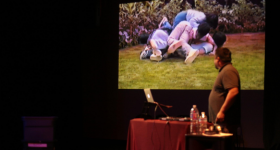Two things I thought I could always fall back on were a home cooked meal and my cultural heritage. These were things I easily took for granted. Moving away from home to go to college made me miss my grandmother’s bubbling pots of Chicken Adobo and steaming bowls full of Pork Sinigang. Who knew that the lack of my trusty Filipino home cooking could result in a lack of confidence in my cultural identity?
So much of my cultural resonance came from the uniqueness of Filipino dishes — the innovation of blending Spanish influences with the Southeast Asian geopolitical location. A history of pain, resilience, and love comes through within each spoonful. Once I lost my food, I lost my culture.
I seldom come across authentic Filipino food in San Francisco — although there are great fusion selections such as Señor Sisig. Most of the great authentic Filipino food can be found in neighboring cities like Daly City or San Leandro. Although a trek on BART can be worth it to get that plate of sweet spaghetti with hot dogs from Jollibee, I figured that I could (and should) make my own versions of Filipino food, in the comfort of my own home in San Francisco.
On a journey to rediscover my love for Filipino cuisine and my passion for my own cultural heritage, I scoured the many aisles, corners, and hidden corridors of Asian markets across San Francisco’s districts. I thought that I would see some familiar ingredients and my brain would spark up something remarkable. I did see familiar ingredients that I would often see spread across my kitchen, hidden within the cupboards that housed my family’s secrets to deliciousness. Who would know those secrets better than the master behind the food? Who would know better than my own grandmother?
Over the course of the past semester of my junior year in college, I found myself learning more about my cultural heritage and API identity through relevant coursework, but I wanted to learn those things from my own home — from my own family. My phone’s “recent calls” page listed the name “Lola” (grandmother in Tagalog) what seemed to be about a million times. She shared recipes upon recipes. Stories upon stories. Memories upon memories.
The recipe that I drooled and salivated over most, my grandmother’s Pork Sinigang, turned out to be the easiest and most fun to learn — even if it was over the phone. We joked and laughed about the different vegetables to include, how long to boil the broth, and the precision, or lack thereof, of measurements. I learned more about my family’s history and about my own cultural history.
I learned more about how my grandmother learned these recipes from her mother in law because her mother worked long nights to support their family when she was younger. I learned about my grandmother’s childhood, living in Batangas City when she rode horses with her siblings around in the tall grass fields surrounding her house. I learned about her father fighting side by side with American soldiers during World War II, hiding from Japanese soldiers underneath floorboards in abandoned houses with the sounds of gunshots echoing from generation to generation.
I realized that my grandmother wasn’t there to just act as a Filipino cookbook full of exploitable dishes that I can use to stuff my stomach. My love for her home cooked meals (and food in general) acted as a catalyst to learn more about where I come from, my culture, and ultimately myself.
I always hear people preach, “food brings people together.” The saying definitely holds true. Cultural foods are not only defined by their ingredients, textures, or flavor profiles. Cultural foods have vast and diverse histories and stories to tell through each bite, slurp, and chew. Whether it be a masterful family member or a spectacular online archive, recipes are out there waiting to be used.
All I know is that this summer while I’m back home with my family, I’ll be spending my time in the kitchen with my grandma.










Comments